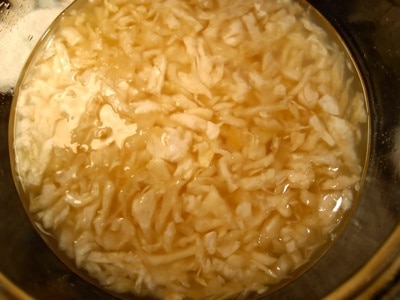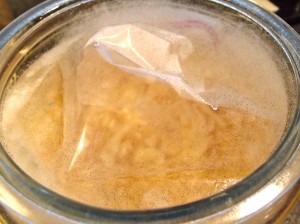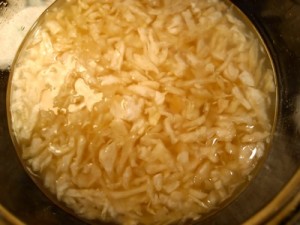So you picked up a copy of Wild Fermentation and became a lacto-fermentation groupie, huh? It happens, I get it, it happened to me. And why wouldn’t you want to ferment everything in sight? The result is tasty, nutritious, rooted in the oldest traditions of food preservation and kinda badass in a “I dance with the microbes in the pale moonlight,” kind of way.
But, in the immortal words of Gregory House, “microbes can be sneaky.” Lacto-fermentaion can go wrong…wrong temperature, wrong salt, wrong brine strength and you end up with pickles no one is going to eat.
Dixiebelle over at Eat At Dixiebelle’s talked recently about some fermentation troubles she’s been having. It can be discouraging to jump head first into the brined life only to discover that there are pitfalls in the art and science of lacto-fermentation. Although I maintain that lacto-fermentation is the easiest food preservation technique going, I’ve run into some weird stuff and you might too.
Here’s how to know if your weird stuff isn’t actually that weird.
First, a disclaimer: if your lacto-fermented stuff is slimy, slippery, super mushy, funky smelling (in a bad way, not a normal pickle way), changes color dramatically (like it turns pink) or otherwise appears to be weird in the ferment itself, chuck that shit out and don’t eat it. Let’s be honest: no one reading this blog on their iPad or their Dell laptop is actually facing starvation if they throw out their tenderly-made but now-questionable pickles, so why risk it? For details, check this out this safety sheet on what is and is not acceptable in pickled products.
Now that we’ve gotten that out of the way, the vast majority of sketchy stuff you’ll see when you ferment is just fine and isn’t going to hurt you, assuming you’ve followed some basic fermentation rules:
- Keep it clean – all jars, weights, utensils, etc. should be strictly clean. I don’t necessarily sterilize, but I make sure crocks, etc are sparkling clean and free of any residue.
- Keep it under brine – you must weight down your ‘kraut or your pickles or your beans, all the way. They will want to float to the top. Don’t let them. Fermentation is an anaerobic process. Add air and you get rot.
- Keep it salty – especially as you start out, follow an established recipe for brine strength or ratio of salt to cabbage for sauerkraut. I swear by Sandor Katz’s brine ratio of 3 tablespoons sea salt to each quart of water for brining.
If you’ve done all of the above, and you are seeing weirdness in your ferment, chances are you are looking at surface yeasts or molds.
A whitish bloom that covers the surface of the ferment and is often described as “scum” is probably wild yeasts growing on the brine surface where they have access to air. The edges of this picture show the whitish scum. This is totally normal. Skim off and discard.
If white or bluish splotches that sit like unwelcome lily pads on your brine show up, floating on your brine, your ferment has grown little mold colonies. They are also taking advantage of the air-contact space on the top of the brine. While gross, these are also normal…ish. Skim off and discard.
The important thing to remember about either of these scenarios is that they are a surface issue, and the ferment, which is submerged, is protected by the salty/acidic brine. Again, anything unexpected inside the ferment itself is always grounds for starting over from scratch.
So now that you know what is normal, I’ll come clean about my own fermentation head-scratcher situation. The other day, I noticed something funky on my own batch of kraut. It was a little freaky, I’ll admit, and not something I’d ever seen before on a ferment.
There was a whitish, fuzzy mold growing around the perimeter of my glass kraut crock, between the ziplock baggie filled with water that I used to weight down the sauerkraut and the glass lid. It looked like the kind of mold that might grow on a strawberry or a peach. Normally, I’d file this under “don’t risk it” and sadly toss out my kraut.
But, when I carefully removed the baggie and the mold that was attached to it, and wiped away all visible signs of the mold from the edge of the jar, underneath the baggie my sauerkraut was pristine. It had good texture and color and it smelled right.
It’s been a few days and the kraut has stayed mold free. I replaced the mold-covered, water-filled baggie with a new, clean, water-filled baggie. (Yes, I am aware that it is not ideal to use plastic like this in a ferment that gets acidic and I’m working on a suitable substitute weight for these glass crocks.)
As of now, the kraut still looks good, smells good and tastes good – I tasted it and I’m still here to tell the tale. I’m thinking it’s time to move this ferment into refrigerated cold storage, but that it is still safe to consume.
However, since I know people with more lacto-fermentation experience than I (and perhaps even a spores, mold, and fungi expert or two!) occasionally read this blog, if I need to put down the fork and the crock and go see a mold specialist right now, someone tell me, ok?
What are your fermentation flops? And what would you do with kraut that grew some fuzz, but only above the brine weight?
632


My first batch of kraut is currently in the works, and I believe it’s about ready to be put in the fridge. Like a few other folks, some of the top layer of cabbage in my crock was mushy, a bit slimy even (a result of not having the best weigh system, I think). I scrapped it and all of the scum off, and what was under still seems good, crunchy, etc. It was a relatively large batch, so I’d obviously prefer not to waste it it, but the mushy later has me worried. Are there any really solid indicators (for a beginner) of whether the kraut is still good? Also, what should it smell like?
Thanks!
I was wondering the same thing. What does bad kraut smell like? Can you compare it to ….say, animal dung?
I made my first batch of saur kraut this year. Put it in my grandmother’s old crock, covered it with 2 leaves off the head, then weighted it with a gallon ziplock filled with water, pressing it down from inside the bag to get out any air between the bottom of the bag and the kraut before I zipped it up. Put the old crock lid on the pot, stuck the whole thing in a cake pan in case it leaked, and put it under the kitchen table. I didn’t open it at all, not for 4 weeks. When I finally unveiled it, it was perfect. And yummy good!
I have two batches of kraut going right now. Was gonna can it this weekend but there is greenish colored mold on the big crock. I put cabbage leaves on top of the kraut and then a heavy plate and a car filled with brine to weight it down, it appears to be fine. will uncover it this weekend and see what it looks and smells like. there was white mold on it the other day, just skimmed it off. The smaller batch seems fine. What happened?
Thanks! This was super helpful. I found many recipes on how to make kraut but not too many telling me what to watch for, what is normal and what is not.
i found mold or fungus that is smooth and dark yellow, and the roundish. It feels like broken pieces of a ceramic plate. Sometimes it was also blue.
I made Jota (a stew) last night (sauerkraut, potatoes, bacon bits) and left it out for 6 hours by mistake. Will the sauerkraut keep this dish from going bad or do I have to throw it out.
I’ve been making sauerkraut regularly for about a year and a half now. Every batch has come out perfectly. I don’t know if that is beginner’s luck or my equipment, but here is what I use: I got interested in lacto-fermentation after reading/viewing an article by Mark Frauenfelder on BoingBoing. He uses the Picklemeister pickle crock, a gallon glass jar with an air-lock valve built into the lid, which I acquired from WisemenTrading.com. (much cheaper than the wonderful Harsch crocks). Also, for his weight to keep things submerged, he uses a brine-filled ziplock bag, instead of plain water, in case of leaks (which apparently I’ve had a couple of). I’ve had absolutely no mold at all, and fine-tasting kraut in as little as 7 days, although 14 seems to be better.
So… Just opened my very first batch of sauerkraut. It has been sitting in the hall for 5 weeks. Been quite warm when the heating is on and quite cold when it’s not. It’s been in a Harsch croc, and have not opened the lid since it was put in, kept rim topped up. I have never heard gurgling once, though work full time so maybe it did it when I was out! Having done lots of geeky googling on what to expect, was expecting White film and bits of mould. When I opened it today – nothing! Cabbage looks totally clean, and there was a while filmy stuff on the weighting stones, but nothing! Cabbage tastes and looks good, crunch, bit of a pickled taste, but am wondering maybe it didn’t actually ferment at all! Is this too good to be true?
Howdy, i packed 24 jars of fermented green & purple cabbage, a fermented mixed batch containing kale, bok choi, pak choi and a chinese cabbage variety. I usually finish the last jar by end of spring. I keep the jars in a dark cool cabinet on the floor where it stays cool during the fall through winter, i also keep the fresh chicken eggs and pickeled salmon there as well. I have not had the mold problem until after i have opened a jar….. in that case i have scraped off the mold and eat, no problems so far.
Just made my first batch of kraut. The bottom of the jar has some dark brown floaties. Is this mold? And is it still safe to eat?
Especially informative… looking frontward to visiting again
Re growths on the top: I have noticed at the height of fermentation large amounts of very white friable powder floats to the surface. I believe this is candida albicans, not necessarily the same subvariety that causes thrush but it is floated out from below by the methane bubbles where it is working in an anoxic environment. But if you leave it THEN as a high protein medium it is itself colonized by pink or blue mold. My solution is to have made a floating top of (loose) oak boards that fit very well and this yeast comes up through the cracks and clings to them nicely when they float up as you remove a top cross board that sits above the brine level and on which I rest a stone. Every two days (cooler weather here) I remove them carefully, and rinse boards in the sink, and remove the yeast ring around the crock with a tissue. Replace clean boards, stone and cover with a plastic bag or something. Of course it is critical to always maintain the correct brine level, if the top board goes under it is much harder to keep everything clean.
I think I got mold because my carrots were not as fresh as they could have been and it was warmer in my home since I was fermenting in the summer in Memphis. To weight down my ferments, I came up with this idea: an unbleached coffee filter, dipped in olive oil and filled with clear glass marbles (had some from my mom used in flower arranging), put it on top and screw the lid down tight. It’s worked really well. To counteract the heat issue, I’m going to put the ferments in a cooler and include a small cold gel pack, not touching but cooling to the low 70’s hopefully. Don’t think I’ll let it go three weeks either.
I appreciate your writing and your humor! Be blessed.
This is my second time in making kraut, The first was a breeze. I had working brine before I finished filling my crock. This time, not so much. I know I started with too little salt. So I guestimated on a brine solutiion for the cabbage in the crock. After a week no sign of fermentation. The kraut was not complete;u covered with brine. So I added more brine, put my plate and water bottle back on the top and decided I need to seal it up with plastic wrap. Two day later, white fuzzy mold all around the edges of the plate. I took off the mold and affected kraut, added more brine and this time it is covered. Returned my plate and weight, put the lid on top of the plate and covered the works with a kitchen towel. It tastes ok. I am in a wait game now. Sure hope it turns out. 5 gallans is a lot of work!!
I tried making sauerkraut for the first time and has a terrible experience.
I made two jars of it. After 3 weeks there wasn’t much change so I waited 6 weeks. One of the jars developed mold colonies on the surface of the brine so I threw it away.
The other on the other hand looked perfect. So I put some on my plate and started to enjoy it when I felt I was chewing something hard. I spit it right away and it was a dark chunk of idk what covered with mold or the mold was inside of it. Idk. Terribly disgusting.
I am traumatized now but still want to make sauerkraut again. Yet idk how come there was mold inside the sauerkraut.
Please help!
I just checked my crock after 10 days and it smelled like absolute garbage. Like…gag-worthy.
So I was about to dump it all out, but I dug into the kraut and pulled out a pinch. It looks fine and smells like very strong fermenting beer.
The surface of the brine has white and bluish mold but the stones were still submerged.
I didn’t taste the kraut because I’m unsure.
I washed the stones and put them back and put the lid back on until I get an answer.
Do you think it’s still okay? How much longer should I wait?
Just made my first attempt at the safer kraut thing. I used an old 5 gallon churn with 10 heads of cabbage, covered with whole leaves , a saucer and a qt jar of water as a weight. when i checked on it in 2 weeks the area outside the saucer was covered with a thick mat of blue colored mold. Although the cabbage underneath still smelled ok (for fermented cabbage) I threw it on the compost pile. At this rate I’m better off just buying cold kraut at the grocery.
I’m done with this crap.Too much loss.
Mike,
The first time I made kraut it was perfect. Ever since then I’ve tried about 5 more times and ended up with rotting garbage.
Next attempt I will bleach everything first.